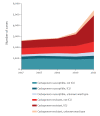Large increase in bloodstream infections with carbapenem-resistant Acinetobacter species during the first 2 years of the COVID-19 pandemic, EU/EEA, 2020 and 2021
- PMID: 36398574
- PMCID: PMC9673235
- DOI: 10.2807/1560-7917.ES.2022.27.46.2200845
Large increase in bloodstream infections with carbapenem-resistant Acinetobacter species during the first 2 years of the COVID-19 pandemic, EU/EEA, 2020 and 2021
Abstract
Recent data from the European Antimicrobial Resistance Surveillance Network (EARS-Net) show a large increase of +57% in Acinetobacter species bloodstream infections in the European Union and European Economic Area in the first years of the COVID-19 pandemic (2020-2021) compared with 2018-2019. Most were resistant to carbapenems, from intensive care units, and in countries with ≥ 50% carbapenem resistance in Acinetobacter spp. in 2018-2019. This highlights the requirement for reinforced Acinetobacter preparedness and infection prevention and control in Europe.
Keywords: Acinetobacter; COVID-19; EU/EEA; bacteraemia; pandemic.
Conflict of interest statement
Figures



References
-
- European Centre for Disease Prevention and Control (ECDC). Rapid risk assessment: Carbapenem-resistant Acinetobacter baumannii in healthcare settings – 8 December 2016. Stockholm: ECDC, 2016 Available from: https://www.ecdc.europa.eu/en/publications-data/rapid-risk-assessment-ca...
-
- European Centre for Disease Prevention and Control (ECDC). Antimicrobial resistance in the EU/EEA (EARS-Net) - Annual epidemiological report for 2021. Stockholm: ECDC; 2022. Available from: https://www.ecdc.europa.eu/en/antimicrobial-resistance/surveillance-and-...
-
- European Centre for Disease Prevention and Control (ECDC). TESSy – The European Surveillance System – antimicrobial resistance (AMR) reporting protocol 2022 – European Antimicrobial Resistance Surveillance Network (EARS-Net) surveillance data for 2021. Stockholm: ECDC; 2022. Available from: https://www.ecdc.europa.eu/en/publications-data/ears-net-reporting-proto...
-
- European Centre for Disease Prevention and Control (ECDC). Surveillance atlas of infectious diseases. Stockholm: ECDC; 2022. Date accessed: 25 October 2022. Available from: https://www.ecdc.europa.eu/en/surveillance-atlas-infectious-diseases
MeSH terms
Substances
LinkOut - more resources
Full Text Sources
Medical
Miscellaneous
